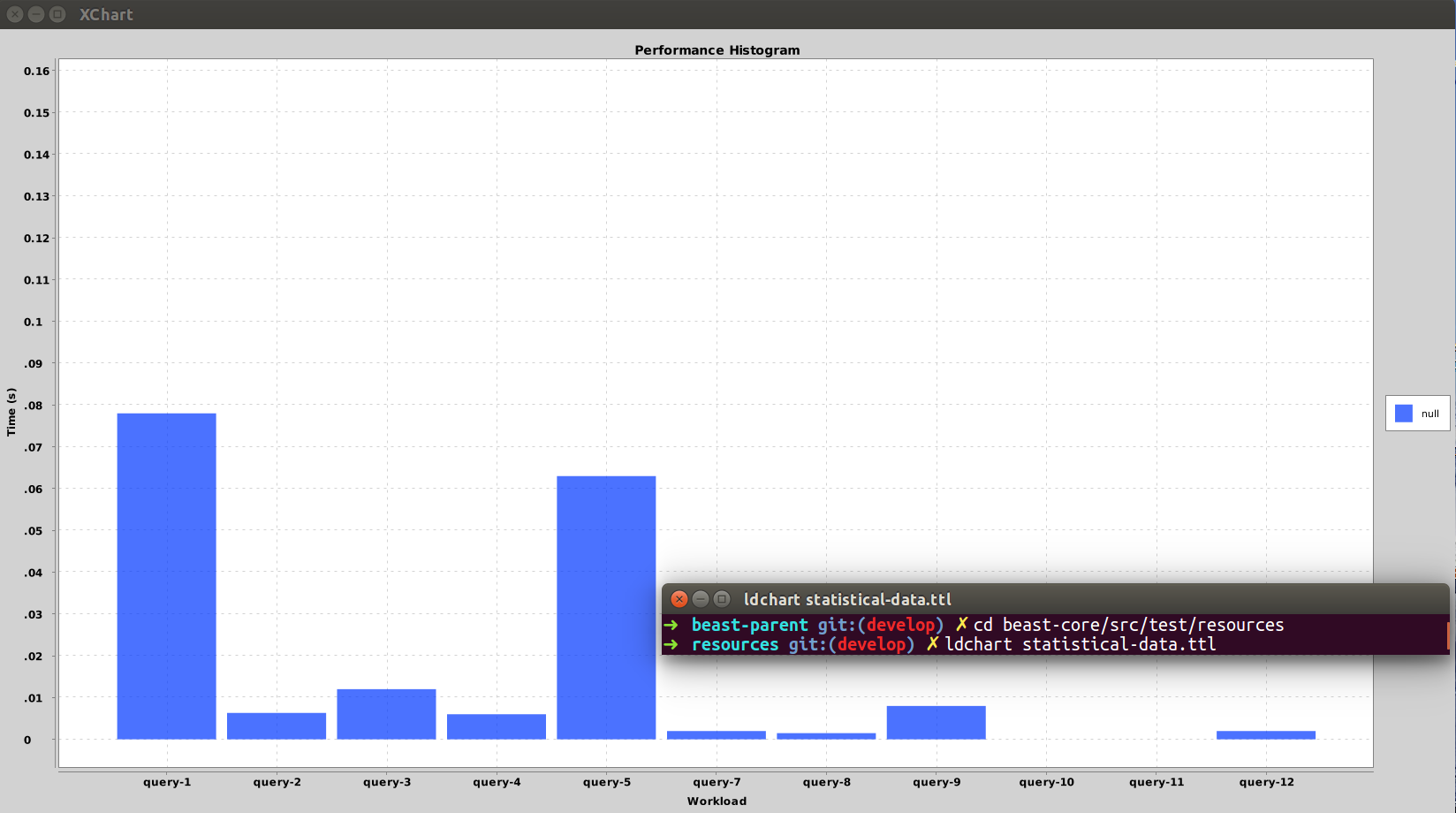BEAST - Benchmarking, Evaluation, and Analysis Stack
Beast is a lightweight framework that makes it easy to build RDF-in/RDF-out workflows using Java8 streams and Jena. For instance, if you want to execute a set of tasks described in RDF, Beast easily lets you create workflows that execute them as often as desired and record any measurements directly in RDF using the vocabulary of your choice (such as DataCube).
Charts in RDF - the Chart Vocabulary
The chart vocabulary enables embedding information about which charts to render from a dataset directly in RDF. The full dataset example is here.
eg:exp1
a cv:StatisticalBarChart ;
rdfs:label "Performance Histogram" ;
cv:xAxisTitle "Workload" ;
cv:yAxisTitle "Time (s)" ;
cv:width 1650 ;
cv:height 1050 ;
cv:style eg:exp1-style ;
cv:series eg:exp1-series ;
.
eg:exp1-style
a cv:ChartStyle ;
cv:legendPosition "InsideNW" ;
cv:yAxisLogarithmic true ;
cv:yAxisTicksVisible true ;
cv:xAxisLabelRotation 45 ;
cv:yAxisDecimalPattern "###,###,###,###,###.#####" ;
.
eg:exp1-series
a cv:ConceptBasedSeries ;
cv:sliceProperty bsbm:experimentId ;
cv:series "some-triple-store" ;
cv:valueProperty <http://bsbm.org/avgQet> ;
bsbm:experimentId eg:bsbm-exp1 ;
.
Charts can be rendered using the class org.aksw.beast.cli.MainBeastChart.
Installing the beast debian package gives you the convenient ldcharts command, which invokes the main class for rendering charts.
cd beast-core/src/test/resources
ldcharts statistical-data.ttl
Usage [Options] file(s)
Option Description
------ -----------
--png Output charts in png format (Default if no other format is given)
--svg Output charts in svg format
--jgp Output charts in jpg format
--gui Display charts in a window
-o, --output <String> Output folder

Features
- Construction of Resource-centric Java streams. Hence, plain RDF properties can be attached to resources as part of the stream execution.
- Extension to Jena which enhances Resources with support for attaching and retrieving Java objects by class. This means you can e.g. attach a parsed Jena Query object to a resource that represents a SPARQL query string.
- Looping with the loops state getting attached to the resource.
- No need to know the URI for resources in advance. You can painlessly give them a proper name at the end of the workflow based on its properties.
While technically Beast essentially provides utilities for chaining functions and streams, a great share of Beast’s contribution lies in its the conceptual considerations.
Components
- Jena Extension: Attach Java objects to Jena resources by casting them to the enhanced resource
ResourceEnh. Requires theModelto be created withModelFactoryEnh:Model m = ModelFactoryEnh.createModel(); m.createResource().as(ResourceEnh.class) .addTrait(myObj.getClass(), myObj); // Short-hand of above version .addTrait(myObj); - RdfStream API: Enables construction of RDF Resource based workflows using the usual streaming methods, such as map, flatMap, peek, and additional ones such as repeat.
- Analysis: Compute new resources representing observations of aggregated values such as averages and standard deviations.
- Visualization: Plot series as charts.
RdfStream
.startWithCopy()
.peek(workloadRes -> workloadRes.as(ResourceEnh.class)
.addTrait(QueryFactory.create(workloadRes.getProperty(LSQ.text).getString())))
.map(workloadRes ->
// Create the blank observation resource
workloadRes.getModel().createResource().as(ResourceEnh.class)
// Copy the query object attached to the workload resource over to this observation resource
.copyTraitsFrom(workloadRes)
// Add some properties to the observation
.addProperty(RDF.type, QB.Observation)
.addProperty(IguanaVocab.workload, workloadRes)
.as(ResourceEnh.class))
.seq(
// Warm up run - the resources are processed, but filtered out
RdfStream.<ResourceEnh>start().repeat(1, IV.run, 1)
.peek(r -> r.addLiteral(IV.warmup, true))
.filter(r -> false),
// Actual evaluation
RdfStream.<ResourceEnh>start().repeat(3, IV.run, 1).peek(r -> r.addLiteral(IV.warmup, false))
)
// Give the observation resource a proper name
.map(r -> r.rename("http://example.org/observation/{0}-{1}", r.getProperty(IguanaVocab.workload).getResource().getLocalName(), IV.run))
.apply(() -> workloads.stream()).get()
// write out every observation resource
.forEach(observationRes -> RDFDataMgr.write(System.out, observationRes.getModel(), RDFFormat.TURTLE_BLOCKS));
;
Which generates output such as:
<http://example.org/observation/q1a-5>
<http://www.w3.org/1999/02/22-rdf-syntax-ns#type> <http://purl.org/linked-data/cube#Observation> ;
<http://iguana.aksw.org/ontology#workload> <http://example.org/query/q1a> ;
<http://www.w3.org/ns/prov#startedAtTime> "2016-12-20T02:57:07.608Z"^^<http://www.w3.org/2001/XMLSchema#dateTime> ;
<http://www.w3.org/ns/prov#endAtTime> "2016-12-20T02:57:07.672Z"^^<http://www.w3.org/2001/XMLSchema#dateTime> ;
<http://www.w3.org/2006/time#numericDuration> "0.063747601"^^<http://www.w3.org/2001/XMLSchema#double> ;
<http://iv.aksw.org/vocab#run> "5"^^<http://www.w3.org/2001/XMLSchema#long> ;
<http://iv.aksw.org/vocab#warmup> false .
Examples
Dependencies
Beast only aggregates features from other (lower-level) projects, among them:
Core:
- jena
- guava
Visualization (Optional):
- JFreeChart
- XChart (probably in the future)